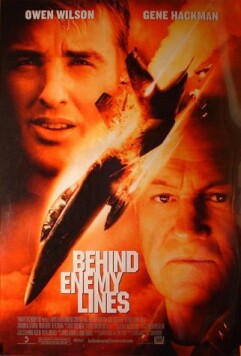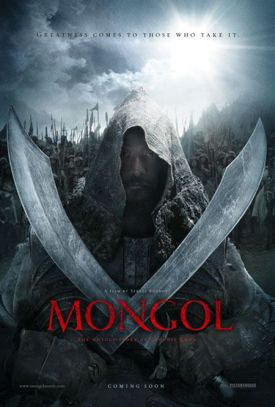Behind Enemy Lines
Owen Wilson has a nose like a bottleneck. It positively has a waist in the
middle. This makes him a natural, I would have thought, for comedy, and hitherto
he has mostly appeared in comic roles, including his first major one, in Wes
Anderson’s Bottle Rocket, and the Jackie Chan vehicle, Shanghai
Noon. In his new picture, Behind Enemy Lines, directed by John Moore,
he plays it serious as Lt. Chris “Longhorne” Burnett, a naval
aviator and navigator on an F/A-18 Superhornet who is shot down over Bosnia because, on
a reconnaissance run, his plane took photos of a mass grave he was not supposed
to have seen. The bad guys are (naturally) Serbs, and they execute his pilot
(Gabriel Macht) while, having safely ejected from the burning plane, Burnett is
off in search of higher ground from which to radio for help.
When he gets in touch with the U.S.S. Carl Vinson, Admiral Leslie Reigert
(Gene Hackman), the commander of the Vinson battle group, orders a rescue party
to go pick him up but he is prevented from sending it by his NATO superior,
Admiral Piquet (Joaquim de Almeida). Admiral Reigert — who has recently
been shown dressing down Burnett for the latter’s impatience with the U.S.
mission (“I signed up to be a fighter pilot, not a cop, and especially not
a cop in a neighborhood nobody cares about”) — tells him to act like
a naval aviator and evade capture, but it is made clear to us that he, as well
as the whole of the ship under his command, shares Burnett’s dislike of
the bureaucratic restrictions that the NATO diplomatic structure and the
“fragile” treaty that the politicians have negotiated with the
Bosnian Serbs impose on them.
Here is really the weakness of the film. We can understand the impatience of
gung ho warriors with diplomatic niceties, especially when one of their own is
in trouble. But the film is not content to leave it at that. Like so many other
Hollywood movies of the recent past, it doesn’t consider its treatment of
politics complete without at least an implicit conspiracy theory. It is
therefore suggested, without being spelled out, that Piquet — oh those
perfidious French! — is in cahoots with the Serbian war criminals and
therefore deliberately interfering with the Vinson’s attempted rescue of
Lt. Burnett. All that stuff about fragile treaties is just a convenient excuse.
Piquet even seems to have Admiral Reigert’s American superiors in his
pocket, though it is not made clear if they are in on the plot.
This is another example of Hollywood’s dumbing down a movie with a
serious theme so that morons and pre-teens can understand it. They looked at the
real-life story of Lt. Scott O’Grady and decided it wasn’t exciting
enough. We’ve got to have it spelled out for us in more familiar terms who
the good guys and the bad guys are and, as always, the former are the soldiers
on the ground and the latter are their superior officers. But sometimes, in the
grown up world, treaties really are fragile and coalition partners really do
have to be placated for really good reasons. Wouldn’t it be more
interesting to see a movie with some real moral, political and military dilemmas
in it? Isn’t it getting a little tiresome even to the people who make
these films to go on treating with such monotonous regularity the U.S. military
and diplomatic authorities as fools or knaves against which the ordinary
soldiers engaged with the enemy must invariably rebel in the pursuit of good and
noble causes? Apparently not.
Having said all that, let me say what is good about the movie. It is
pro-American, pro-military (below the highest echelons, of course) and rather
excitingly photographed. I could have done without the loud bangs on the
soundtrack to accompany significant moments in the action and the photographic
gimmickry of stop action and fast forward, which are also (I think) a kind of
dumbing down. In spite of these, however, the action sequences are quite often
thrilling, especially those involving aerial photography — which seems
more natural and at home in the movies than the scenes of ground combat, which
are by contrast occasionally too “movieish.”
I particularly liked the idea (though it seemed rather improbable) of having
a heat-imaging satellite photo (even watching this in the Vinson’s
communications center “isn’t strictly legal” it is said, since doing
anything good in Hollywood invariably means breaking the rules) as the Serb
killers are seen closing in on Lt. Burnett. We see the heat shadow of the
Lieutenant in a prone position and we see the upright heat shadows of the Serb
detachment approach and then surround it, and yet they seem to mill about,
unable to find him. The watchers on the aircraft carrier, expecting the imminent
death of their comrade, cannot understand what they are seeing, but we are
transported, through the magic of the movies, to the scene on the ground where
we are allowed to see Burnett hiding under one of the bodies in the mass grave
and the Serbs, repulsed by their own handiwork, moving on after bayonetting a
few corpses.
In other words, the film is a political and diplomatic mess. It makes no
sense and only looks like the Hollywood cliché it is for making American
soldiers always and forever at war with their own superior officers before they
are at war with the enemy. But when Reigert defies his orders and goes to rescue
Burnett anyway in the teeth of what looks like a Serb armored brigade, you will
have a hard time coming away from the spectacle without a lump in your throat as
big as the nose on Owen Wilson’s face.
Discover more from James Bowman
Subscribe to get the latest posts to your email.








